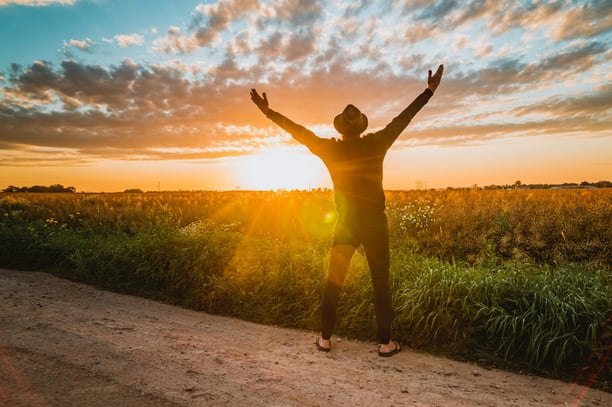
The Gratitude Shift: How I Learned to See Life Through a Softer Lens
This post explores how cultivating a gratitude mindset can transform everyday life by highlighting joy in the smallest, often overlooked moments. Backed by research and practical tips, it shows how gratitude can bring light to difficult times and create a more grounded, hopeful outlook.
HAPPINESS
4/6/20254 min read


Gratitude Rewires the Brain (Literally)
Neuroscience backs this up. Studies show that consistently practicing gratitude activates the brain's reward pathways—specifically areas related to dopamine and serotonin. Over time, it rewires your default thinking patterns to look for the positive. In short, the more you practice gratitude, the easier it becomes to feel it.
Psychologist Robert Emmons, one of the leading researchers on gratitude, describes it this way: “Gratitude allows us to celebrate the present. It magnifies positive emotions.” In one study, people who kept gratitude journals for just 10 weeks reported feeling 25% happier, and exercised 33% more than those who didn’t.
And that’s just from writing things down.
How I Started (and Kept Going)
Let me be real: I didn’t wake up one day a grateful goddess. It was a mess of trial and error, forgotten journals, and eye rolls at first. But these are the things that worked for me—and might for you too:
1. The “Three Things” Rule
Before bed, I’d write down three things I was grateful for. Some days it was deep (“my sister’s support today”), other days it was as simple as “my favorite hoodie.” What mattered was consistency, not perfection.
Sometimes I would take it further and include one thing I usually overlook, for example:
The sound of the radiator (annoying, but it means I have heat)
The random old lady at the bus stop who smiled at me
The fact that I was still here, even on hard days
This twist forced my brain to slow down and really scan for good.
2. Gratitude in Communication
This one isn’t always easy but it’s beautiful: I started telling people when I appreciated them. Not just “thanks,” but real, raw moments:
“You always make me feel heard. I’m really thankful for that.”
“Your honesty helped me more than you know.”
Or even just sending a quick “thinking of you” or “thank you for being in my life” to someone. I never did it expecting a response—but the connection it created felt magic. You’d be surprised how much that opens people up—and how much it heals your own heart.
3. Finding the Good Within the Bad
This one took time. But eventually, I started asking: “Is there anything here to be thankful for?” after hard days. Maybe it was the lesson. Maybe it was just the fact that I made it through. But even the act of asking softened the experience.
Gratitude Doesn’t Erase Pain—But It Adds Light
Let me be clear: practicing gratitude didn’t erase my struggles. It didn’t fix every relationship or banish burnout. But it changed my posture toward life. I started seeing beauty where I hadn’t before. I found joy tucked inside ordinary moments. And slowly, I became less reactive, more grounded, and—unexpectedly—more hopeful.
Gratitude taught me that joy is not a finish line. It's not a destination where everything is finally perfect and still. It’s a practice. A quiet choice. A soft returning.
Sometimes joy is loud—singing in the car, laughing until your ribs hurt. But often, it’s the kind that sneaks in through a crack in your day and reminds you: You are still alive. You are still allowed to feel good things.
And that’s enough.
Final Thought: You Don’t Need a Perfect Life to Feel Deeply Grateful
The Gratitude Shift: How I Learned to See Life Through a Softer Lens
A few years ago, I hit a stretch in life that felt like a series of closed doors. Work was draining, relationships felt off, and even small joys seemed dull. I remember sitting in my car one rainy morning, gripping the steering wheel with tears in my eyes, thinking: “Is this it? Is this what life is supposed to feel like?”
That was the moment I stumbled into the idea of gratitude—not in a Pinterest-quote kind of way, but as something deeper. Something that could change the way I see everything.
The Wake-Up Call (aka: It Wasn’t the Big Stuff)
I used to think gratitude was something you expressed when you got what you wanted—like getting the promotion, booking the trip, or watching things fall neatly into place. I thought happiness would return when something finally “clicked.” A vacation. A breakthrough. Some magical reset. But real gratitude, I’ve learned, isn’t built on the “big wins” or events of life. But nothing changed—until I started changing how I noticed things. Noticing the smallest, quietest moments—and letting them count.
It began with the tiniest moments:
The way your coffee smells in the morning when you're half-awake
That one friend who always checks in, even when you don’t reply right away
A stranger holding the door open
The way sunlight hits your floor at 4PM
It was strange how something so small could stir something so big. A flicker of peace. A breath of warmth. Those were the things I started writing down when I began my gratitude practice. It felt awkward at first, even silly. But within a few weeks, something began to shift.


If you’re going through something, I’m not here to tell you to just “be grateful” and move on. I’m here to say: you can hold both. The grief and the grace. The hard and the holy. Gratitude isn’t about denying your pain—it’s about letting joy slip through the cracks.
So tonight, or maybe right now, try asking yourself:
What’s one small thing I can be thankful for—just in this moment?
Let that be your start.
